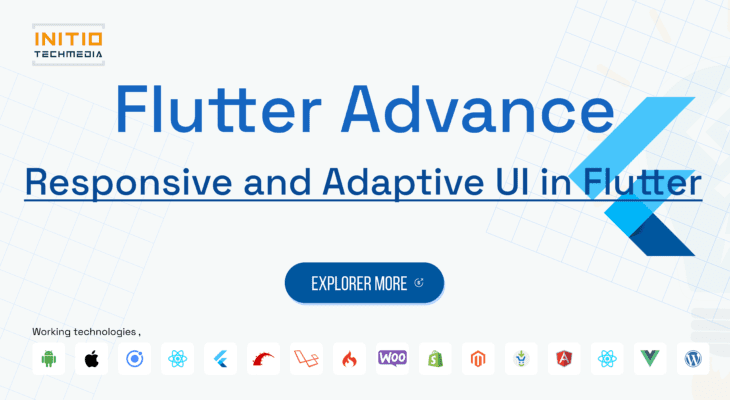Leading Mobile & web Development company which is providing Ready to publish apps & on demands application in Global Bussiness.
- 908, B Square 2, Ambli Rd, near Hotel Double tree Hilton, Vikram NagarAhmedabad-380054, Gujarat, India
- (+91) 8758432204Give us a call
- contact@initiotechmedia.com24/7 online support

Responsive and Adaptive UI in Flutter
- payal patel
- May 15, 2023
- 0
In Flutter, you can create responsive and adaptive user interfaces (UI) using a combination of techniques and widgets. Let’s explore some approaches to achieve responsive and adaptive UI in Flutter:
MediaQuery: Flutter provides the
MediaQuerywidget, which allows you to retrieve information about the device’s screen size, orientation, and other properties. You can use this information to make your UI responsive by adapting to different screen sizes. For example, you can useMediaQuery.of(context).sizeto get the screen size and adjust the layout accordingly.LayoutBuilder: The
LayoutBuilderwidget provides a callback that gives you constraints about the parent widget’s size. You can use these constraints to build a responsive UI. By analyzing the available space, you can modify the layout or apply different widget arrangements based on the constraints.OrientationBuilder: If you want to adapt your UI based on device orientation changes (e.g., portrait to landscape), you can use the
OrientationBuilderwidget. It provides a callback that gives you the current orientation, and you can rebuild parts of your UI accordingly.MediaQueryData: The
MediaQueryDataclass contains additional information about the device’s screen, such as pixel density and text scale factor. You can use this data to fine-tune your UI’s appearance and behavior for different devices.Flex and Expanded: Flutter offers flexible layout widgets like
FlexandExpandedthat allow you to create UIs that adapt to available space. By combining these widgets with appropriateFlexFitproperties andmainAxisAlignmentvalues, you can design layouts that resize and reflow elements based on the screen size.MediaQuery.of(context).orientation: By accessing the
MediaQuery.of(context).orientationproperty, you can determine the current device orientation and modify your UI accordingly. For example, you may want to display a different layout or adjust the alignment and spacing between widgets when the orientation changes.Responsive UI Packages: Flutter has several third-party packages that can help you build responsive UIs more easily. Packages like
flutter_screenutil,responsive_builder, andsizerprovide additional utilities and widgets to simplify the process of creating adaptive layouts.
Remember that designing a responsive and adaptive UI is a combination of using appropriate widgets, handling different screen sizes and orientations, and testing your UI on various devices to ensure a consistent and user-friendly experience across different platforms.
WhatsApp us

